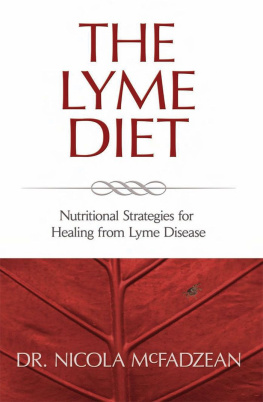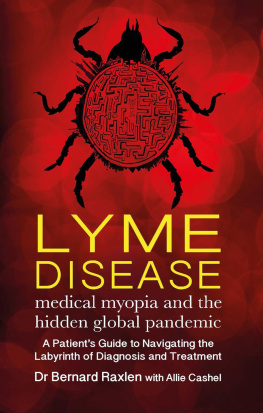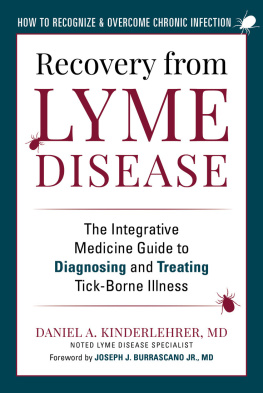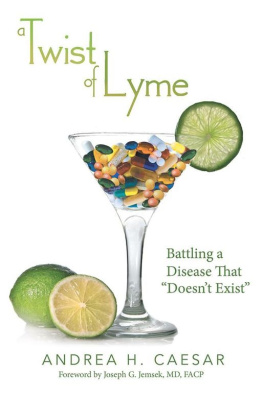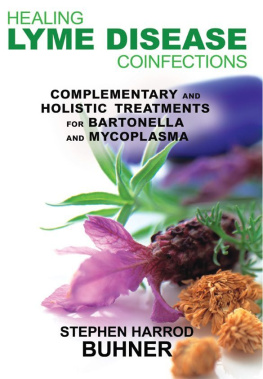BioMed Publishing Group
P.O. Box 550531
South Lake Tahoe, CA 96155
www.LymeBook.com
Copyright 2012 by Nicola McFadzean, N.D.
ISBN: 978-0-9882437-1-2
All rights reserved. No part of this book may be copied, transmitted, or stored in a database without permission.
For related books and DVDs, visit us online at www.LymeBook.com.
The eBook version of this book was created by FormattingExperts.com
DISCLAIMER
This book is not intended as medical advice. It is also not intended to prevent, diagnose, treat or cure disease. Instead, the book is intended only to share the unofficial research and opinion of the author. The book is provided for informational and educational purposes only, not as treatment instructions for any disease. Much of the book is a statement of opinion in areas where the facts are controversial or do not exist. The information in this book should not be considered any more valid than any other type of informal opinion.
The book was not written to replace the advice or care of a qualified health care professional. Be sure to check with your own qualified health care provider before beginning any protocols or procedures discussed in this book, or before stopping or altering any diet, lifestyle, or other therapies previously recommended to you by your health care provider. The treatments described in this book may have side effects and carry other known and unknown risks and health hazards.
Lyme disease is a controversial topic and this book should not be seen as the final word regarding Lyme disease medical care. The statements in this book have not been evaluated by the United States FDA. Use of the information in this book is at your own risk.
To purchase books and DVDs on Lyme Disease and related topics, please visit www.LymeBook.com
CONTENTS
SECTION THREE:
Treatment Guidelines for Lyme Disease
ACKNOWLEDGMENTS
FIRST, I WANT TO THANK MY PUBLISHER BRYAN ROSNER FOR HIS motivation, guidance and amazing partnership in this project. Thank you for the time you poured into the manuscript, for the knowledge and experience you brought to it, and the sense of support and camaraderie that you provided for me along the way. Dr. Burrascano, I am deeply honored that you have supported this bookthank you for carving out the time to go through it all; and for your positive feedback and endorsement. It means so much to me.
Thank you to Kim Junker, best friend extraordinaire, for your amazing editing contribution, and also for your friendship and encouragementwe make a great team! To Adriana Covell, thank you for keeping my practice running while I was focused on writing, and for understanding when I wasnt available for other projects. Scott Forsgren and Connie Strasheim, thank you for the time you generously spent on the manuscript and the helpful suggestions you made.
Finally, thank you to all my patients, for allowing me to love the work I do every single day, for the gratitude and appreciation you give me and for allowing me to contribute to you. Your strength and determination to keep moving forward in the face of hardship is inspirational, and it makes me love and respect you all the more.
FOREWORD
I BEGAN MY PRACTICE OF PRIMARY CARE INTERNAL MEDICINE IN 1981 in a small town in coastal New York, known for its natural beauty untouched pine forests, wetlands, and many wild animals. It is also part of the coastal bird flyway, through which our feathered friends travel as they migrate from one hemisphere to the next. Ominously, it also is located just 30 miles across the water from Lyme, Connecticut.
Soon after I set up my office, in addition to seeing the usual ailments common to this type of medical practice, I did note that there was a surprisingly large population of patients with strange illnesses. How could a relatively young person have a degenerated right hip, while the left hip, obviously the same age, was fine? Why so many atypical cases of Lupus? And what about the many patients with unexplained brain fog and confusion, to the point of having difficulty making sentences? The nerve tingles, the insomnia, the fatigue, the head and body aches, the anxiety, the depression that always was associated with knee pains?
Well, as I was to find out a few years later, my little town would become noted for having the highest reported case rate of Lyme disease in the world!
Lyme disease is not a new illness. It has been recognized, in one form or another, for over a hundred years. In unraveling its history, one can see many instances of missed opportunities, unrecognized patterns and outright mistakes by scientists, physicians and government officials. Over time, a divide developed between the front-line, Lyme-treating physicians, and the scientists and physicians at our major institutions, both at the university level and in government.
How did this come to be? What have been the consequences? Could any of the troubles we are now facing in the Lyme Wars have been prevented?
My personal Lyme story began in the mid-1980s when the pathologist at my local hospital, the genius Dr. Alan MacDonald, one day invited me to his makeshift skunkworks, a little lab he created in an abandoned part of the hospital morgue. There he showed me his custom-built microscope, but more importantly he had me look through the eyepiece. And there they werecrazy looking undulating thread-like bacteria that he was able to grow out from the blood of many of my patients. Yes, they were Borrelia burgdorferi, the spirochetal bacterium known to cause Lyme disease.
As it turned out, Dr. Willi Burgdorgfer had collected the actual ticks from which he discovered this germ, which was eventually named after him, from a spot within a bike ride from where I lived and worked! He and Dr. MacDonald became friends and colleagues and together they laid the foundation for the modern concept that Lyme disease is in fact an infectious disease.
To gain perspective, one must go back in time a few years. In 1975, after many calls from residents of Lyme, Connecticut, led by Ms. Polly Murray, the U.S. Centers for Disease Control sent Dr. Alan Steere, a rheumatologist and epidemiologist, to Connecticut to study this cluster of unusual rashes and painful swollen joints. Two years later he published a study of 51 cases of a new clinical entity and called it Lyme Arthritis. He recommended treatment with aspirin and steroids; he considered it self-limited and saw no benefit from treatment with antibiotics. After all, he is a rheumatologist and not an infectious disease specialist.
After the discovery by Dr. Burgdorfer, the need to treat this bacterial infection with antibiotics became accepted. But which antibiotics? At what does? And for how long?
Steere conceptualized Lyme as being an illness that displays both major manifestations and minor manifestations. He and his colleagues defined successful treatment as the elimination of the major symptoms (Bells palsy, acute carditis, inflammatory arthritis) even though, in Steeres belief, they usually would resolve over time without treatment! They also basically dismissed the minor manifestationsthe headaches, fatigue, body pains, confusion, nerve tingles and numbness, etc.
They assumed, without any proof, that the remaining minor symptoms reflected a non-infectious immune-mediated phenomenon, and called it the "post-Lyme syndrome."
Having treated many Lyme patients by then, I recognized that in disseminated disease, ten to fourteen day courses of antibiotics would either result in only a lessening of the illness, or an initial good outcome followed by a relapse. The patients would then respond again to a repeat course of antibiotics. Based on this experience, and looking through Dr. MacDonalds microscope and using his


